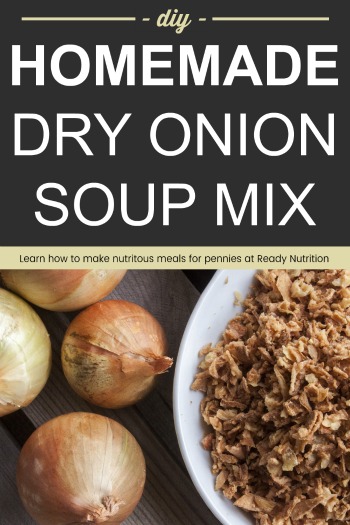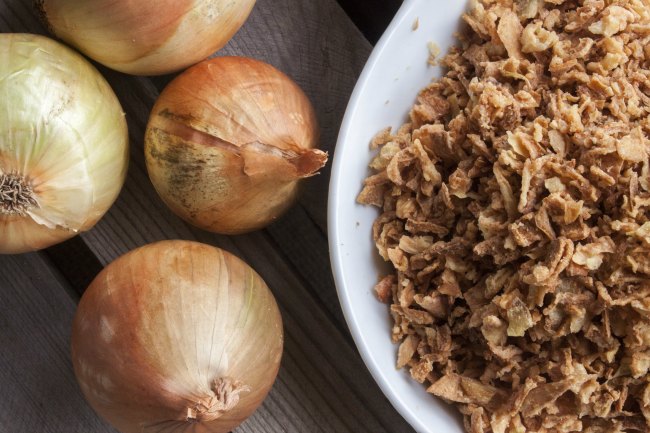Dry onion soup mix is a versatile pantry staple that can be used for soups, dips, casseroles, and even mixed in to add a little oomph to dinners. We like to make our own soup mix because, oftentimes, onion soup that is purchased in grocery stores is laced with harmful preservatives like sulfur dioxide and monosodium glutamate and artificial colors and flavors. Plus, it’s incredibly easy to make it at home and you get to control the ingredients used!
In fact, there are several advantages to making your own dry soups. If you are frugal, it can save you some money. There are far fewer artificial ingredients and you can control the sodium level. Plus, it can save you time! Homemade dry onion soup mix is great to have on hand for “just add water” meals and to season meats and dishes. It’s also great to add to “cream of something” soup or used to make French onion dip too (just add a pint of sour cream to the recipe)! Just make some homemade potato chips or sweet potato chips and you’re set! You’ve got a healthy snack for your little ones to enjoy!
To start, you may want to know how to use a dehydrator. This will come in handy if you REALLY want to make your soup mix from scratch and start with fresh ingredients. And dehydrators are more often than not worth the investment! The Prepper’s Cookbook hails this culinary tool as a must-have for creating a stocked pantry. Additionally, this is a great way to use up extra produce you have that you need to get rid of.
If you do decide that dehydrating your vegetable is right for you, keep some of these rules in mind:
- You can dehydrate any fruit or vegetable, regardless of quality or ripeness. If something is too ripe and soft, you can always puree it and dry the puree. Although using the best quality fruits and veggies will result in the best quality dried goods, remember that the goal here is preservation, not perfection. So don’t be afraid to dehydrate the bruised, overripe, and slightly damaged goods. Just make sure not to put mold in the dehydrator as it can spread and infect the rest of the foods.
- Some food items can be air-dried. Herbs and other green leafy food sources, in particular, do not necessarily need a dehydrator. They can be set out of the way and air-dried.
- Some foods need to be blanched. Blanching certain foods like onions, mushrooms, and tomatoes ahead of time will limit discoloration and the risk of food-borne illnesses. This isn’t necessary, but it certainly helps in the longevity of your dried foods.
- Cook potatoes thoroughly for further enjoyment. Potatoes, beans, and other root vegetables should be cooked thoroughly and then dehydrated. I’ve made a pot of beans and dehydrated them for soups. I have also made dehydrated potato flakes to use in my prepper pantry.
- Don’t dehydrate foods from different families at the same time. If you are dehydrating foods from different family groups, the flavors can cross over. For instance, if you are dehydrating tomatoes and peppers, note that the tomatoes will end up being spicy. As well, any Brassica should be dehydrated on its own, otherwise, the sulfur taste will permeate into the other foods. The only exception is dehydrating fruits. Fruits can be mixed together, but mixing them with strong-tasting or smelling vegetables is not recommended.
- Be consistent with your cut size and spacing. Try to keep the slices of food the same thickness to encourage even drying times. As well, try not to allow the food to touch one another or overlap (green leafy vegetables are ok though). Otherwise, it can block the airflow and prevent drying.
Once you’ve figured out whether or not to buy the dried ingredients or make them yourself, you can get going on your homemade dry onion soup mix! It’s easy, fun, and a hands-on way to get your kids involved in the kitchen.
Recipe for Homemade Dry Onion Soup Mix
-
- 1/4 cup dried onion flakes
- 2 Tablespoons beef bouillon granules
- 1/4 teaspoon onion powder
- 1/4 teaspoon dried parsley flakes
- 1/8 teaspoon celery salt
- 1/8 teaspoon paprika
- 1/8 teaspoon freshly ground black pepper
Mix all ingredients together. Store in an airtight container. Use in recipes that call for one envelope of dry onion soup mix.
A Few More Tips:
Play around with the quantities of the ingredients. You’re making this yourself, so why not tailor the recipe to YOUR tastebuds?
Try adding homemade dry onion soup mix to some homemade egg noodles! It’s really good and a different from the “run of the mill” dinners most of us have become accustomed to.
Try some more recipes using a dehydrator! Fill up your prepper pantry with delicious homemade staples!

This article was originally published at Ready Nutrition™ on November 7th, 2019







